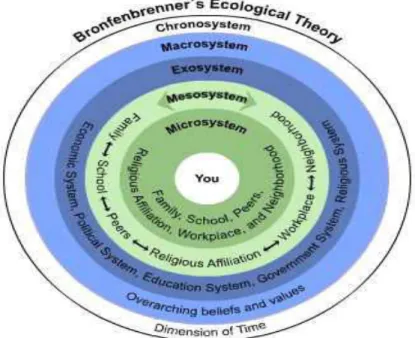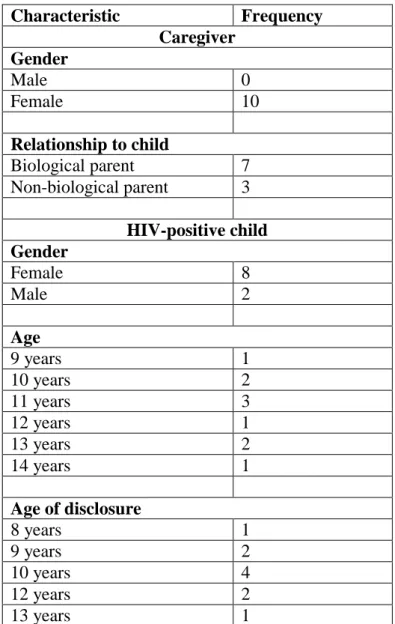2 With the increasing population of HIV-positive children comes the responsibility of disclosing the child's HIV-positive status to those of their caregivers. It is suggested that disclosure of the child's HIV status can be seen as a tool to promote survival, as it appears to be associated with increased adherence to treatment among HIV-positive children (Krauss, Letteney, De Baets, Baggaley and Okero ). , 2013). The child's mental stability and age appear to be the key determinants of disclosure of HIV-positive status to the child by the caregiver (Weiner et al., 2007; Lesch et al., 2007).
It is suggested that disclosure of the child's HIV-positive status to them can be seen as a tool to promote survival, as it appears to be associated with improved adherence to treatment among HIV-positive children (Krauss et al., 2013) . . Some of the positive factors related to the disclosure of their HIV-positive status to the child are the promotion of trust between the child and the caregiver, open family communication (since there will be no secrets in the family, which improves communication in the household), improved attachment to the treatment (since the children now know their HIV-positive status, so they will work together with their parents or carers when it comes to treatment), and improving the child's well-being (Wiener et al. , 2007). Age as one of the key determinants of disclosure seems to be supported by the cognitive theories relating to the child's perception of illness.
The main reason for the disclosure was related to the child's perceived maturity as well as the child's ongoing questioning. At the mesosystem level, caregivers interact with peers, family members, and the neighborhood (other parts of the child's microsystem). 25 or prevent transmission of HIV-positive status to the child and the benefits of transmission of HIV-positive status to the child.

Introduction
Introduction of themes………………………………………….………………….....29-31
- Internal stigma
- External stigma and discrimination…………………………………………36-37
- Guilt, shame and embarrassment as a challenge in disclosure……………..40-41
- Children questioning of medication………………………………………...41-42
- Government policies influencing disclosure
This topic focuses on the various factors that positively influence a caregiver's decision to disclose a child's HIV-positive status. Participants appeared to learn about their status at the same time as they learned about the child's status. Most of the biological guardians of children living with HIV found out about the child's status after birth and when the child started to get sick (n=6).
Two of the three non-biological caregivers also learned about the child's status when the child began to become ill, as explained in the participant quotes below. Although they were the biological caregivers of the HIV-positive child, they indicated that they did not learn of the child's HIV-positive status after the birth in the hospital. Only one in seven biological caregivers reported learning about the child's HIV-positive status in the hospital after delivery.
The participant also indicated that she was aware of her own HIV-positive status even before the child's diagnosis. 32 Some participants indicated that they were simultaneously learning about their own HIV-positive status while also learning about the child's HIV-positive status (n=3). It appears that these four caregivers had disclosed the child's status to all family members.
Four participants reported that there was only partial family knowledge of the child's HIV-positive status; the reason for this was that certain family members were too young to understand. The other participant who reported not informing the school of the child's HIV-positive status explained that it was not necessary as she is now a homemaker and is able to care for the child. As discussed in the previous section, most of the participants expressed that they had difficulty disclosing the child's HIV-positive status to others or their children, as they feared that the child might be teased or discriminated against or stigmatized.
For some of the participants, the child's psychological development made it difficult for the caregiver to communicate with them. This theme focuses on the various factors that influenced the caregiver's decision to disclose the child's HIV-positive status to them.
Impact of disclosure for the child and caregiver
Caregiver relief
Improvement in adherence.............................................................................43-45
This theme focuses on whether or not the child's family members had knowledge of the child's HIV-positive status. This theme focuses on the child's self-stigmatization after learning of their HIV-positive status. This theme focuses on the various factors that influence the caregiver's decision to disclose the child's HIV-positive status to them.
This theme looks at the role that doctors play in facilitating the disclosure of the child's HIV-positive status to them. It is also checked whether people and institutions around the child are aware of the child's HIV-positive status. This theme focuses on the knowledge of the family, the community and the institution about the HIV-positive status, but also on the knowledge of the child.
Almost half of the participants in this study reported that their entire family was aware of the child's HIV-positive status. It appears that people who have access to the same facilities prevent them from keeping the child's HIV-positive status a secret. Participants seemed to understand the importance of telling the school, as almost half of the participants reported choosing to disclose the child's HIV-positive status to the school their child attended.
It would seem that for most of the participants in the study, the child's age was a significant factor in considering whether or not the child's HIV-positive status should be disclosed to them. In this study sample, the median age of disclosure of the child's HIV-positive status to them was 10 years old. Most of the participants reported that disclosure to the child was not an easy process to undertake.
Some of the participants who were non-biological caregivers saw the need to disclose the child's HIV positive status after the death of the child's own biological parent. All of the biological caregivers reported that they had experiences of guilt, shame, and embarrassment in disclosing the child's HIV-positive status to them. Most of the biological caregivers interviewed reported that they only learned of the child's HIV-positive status after birth and others reported that they learned when the child started to get sick.
Participants who were biological caregivers reported learning about their child's HIV status when the child became ill.
Conclusion
Summary of themes………………………………………………………………..…46-47
Difficulties experienced in disclosure
This theme focuses on the difficulties that carers experience when faced with the task of disclosure. This theme focuses on the bad treatment of HIV-infected people or any stigma surrounding the virus. This theme focuses on the child's psychological development and how this affects disclosure and communication.
This theme focuses on what healthcare providers experienced when they came to tell their children about their HIV-positive status.
Factors promoting disclosure
Impact of disclosure (for the child and caregiver)
Awareness of child‟s HIV-positive status
49 disclosure of HIV positive status to a child is to promote trust between the child and caregiver and open family communication in the household. It appears that most of the participants who disclosed to the whole family began by disclosing to the family before disclosing to the child. Most participants indicated that they did not directly disclose to the community, but because they used the community clinic, they felt that their neighbors needed to know their child's HIV status.
This is contrary to what individuals would believe would happen if the community found out the child's HIV positive status. This clearly shows that the school and the teachers who form part of a child's exosystem have a significant role to play in helping the child living with HIV adjust better after learning of their HIV positive status. Some of the non-biological caregivers reported that the child's biological parents were in denial about their HIV-positive status and were not taking treatment, nor were they giving the child their treatment.
Thus, non-biological caregivers realized that they had to be actively involved in improving the child's health and help in this by disclosing the child's HIV status to them. 55 supported and were willing to help with some of the responsibilities of ensuring the overall well-being of the child. This is an overarching theme that focuses on the various factors that influenced caregivers' decisions to disclose their child's HIV-positive status.
For most participants, children (and sometimes siblings) having doubts about their ARV medication was seen as a reason for deciding to disclose this to the child. Some were also reported to help and support the caregiver in disclosing to the child. Some participants reported that South Africa's policies to protect the rights of children were also influential in promoting disclosure, such as Chapter 11 in the National Policy on HIV/AIDS (Department of Education, 1999) and the right of the child on health.
That participants only reported knowing their HIV-positive status and the child's HIV-positive status when the child first became ill raises a number of questions. Most participants reported that they needed to tell the child their HIV-positive status because of the child's questioning, as well as the child entering the pre-adolescent stage of development. It is also said to have provided relief to them and promoted greater child participation in adhering to their treatment regimen.
How did you find out about your child's HIV+ status and how old was the child?
